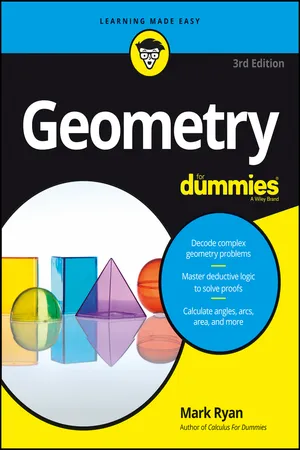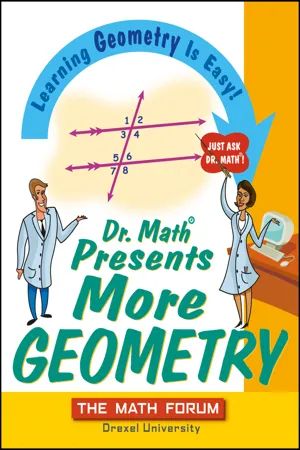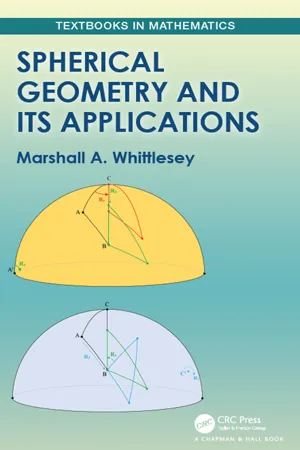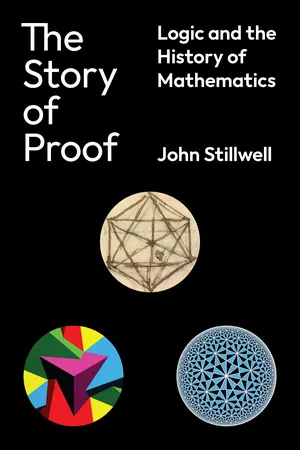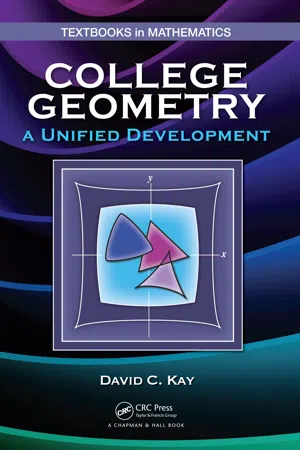Mathematics
ASA Theorem
The ASA (Angle-Side-Angle) Theorem states that if two triangles have two corresponding angles and the included side congruent, then the triangles are congruent. This theorem is a fundamental concept in geometry and is used to prove the congruence of triangles in various geometric proofs.
Written by Perlego with AI-assistance
Related key terms
1 of 5
12 Key excerpts on "ASA Theorem"
- eBook - ePub
- Mark Ryan(Author)
- 2016(Publication Date)
- For Dummies(Publisher)
(If you fill in numbers, you can see that if and were both, and would both be.) Here’s the formal proof: © John Wiley & Sons, Inc. ASA: Taking the angle-side-angle tack ASA (Angle-Side-Angle): The ASA postulate says that if two angles and the included side of one triangle are congruent to two angles and the included side of another triangle, then the triangles are congruent. (The included side is the side between the vertices of the two angles.) See Figure 9-5. © John Wiley & Sons, Inc. FIGURE 9-5: The congruence of two pairs of angles and the side between them make these triangles congruent. Here’s a congruent-triangle proof with the ASA postulate: © John Wiley & Sons, Inc. Here’s my game plan: Note any congruent sides and angles in the diagram. First and foremost, notice the congruent vertical angles (I introduce vertical angles in Chapter 2). Vertical angles are important in many proofs, so you can’t afford to miss them. Next, midpoint E gives you. So now you have a pair of congruent angles and a pair of congruent sides. Determine which triangle postulate you need to use. To finish with SAS, you’d need to show ; and to finish with ASA, you’d need. A quick glance at the bisected angles in the givens (or the title of this section, but that’s cheating!) makes the second alternative much more likely. Sure enough, you can get because a given says that half of () is congruent to half of (). That’s a wrap. Here’s how the formal proof plays out: © John Wiley & Sons, Inc. STICKING TO THE BASICS: THE WORKINGS BEHIND SSS, SAS, AND ASA The idea behind the SSS postulate is pretty simple. Say you have three sticks of given lengths (how about 5, 7, and 9 inches?) and then you make a triangle out of them. Now you take three more sticks of the same lengths and make a second triangle - No longer available |Learn more
- (Author)
- 2014(Publication Date)
- Library Press(Publisher)
If triangle ABC is congruent to triangle DEF, the relationship can be written mathematically as: In many cases it is sufficient to establish the equality of three corresponding parts and use one of the following results to deduce the congruence of the two triangles. The shape of a triangle is determined up to congruence by specifying two sides and the angle between them (SAS), two angles and the side between them (ASA) or two angles and a corresponding adjacent side (AAS). Specifying two sides and an adjacent angle (SSA), however, can yield two distinct possible triangles. ________________________ WORLD TECHNOLOGIES ________________________ Determining congruence Sufficient evidence for congruence between two triangles in Euclidean space can be shown through the following comparisons: • SAS (Side-Angle-Side): If two pairs of sides of two triangles are equal in length, and the included angles are equal in measurement, then the triangles are congruent. • SSS (Side-Side-Side): If three pairs of sides of two triangles are equal in length, then the triangles are congruent. • ASA (Angle-Side-Angle): If two pairs of angles of two triangles are equal in measurement, and the included sides are equal in length, then the triangles are congruent. The ASA Postulate was contributed by Thales of Miletus (Greek). In most systems of axioms, the three criteria— SAS , SSS and ASA —are established as theorems. In the School Mathematics Study Group system SAS is taken as one (#15) of 22 postulates. • AAS (Angle-Angle-Side): If two pairs of angles of two triangles are equal in measurement, and a pair of corresponding non-included sides are equal in length, then the triangles are congruent. • RHS (Right-angle-Hypotenuse-Side): If two right-angled triangles have their hypotenuses equal in length, and a pair of shorter sides are equal in length, then the triangles are congruent. - eBook - PDF
- Michael Hvidsten(Author)
- 2016(Publication Date)
- CRC Press(Publisher)
A B C X Y Z This proposition is one of the axioms in Hilbert’s axiomatic basis for Euclidean geometry. Hilbert chose to make this result an axiom rather than a theorem to avoid the trap that Euclid fell into in his proof of the SAS result. In Euclid’s proof, he moves points and segments so as to overlay one triangle on top of the other and thus prove the result. How-ever, there is no axiomatic basis for such transformations in Euclid’s original set of five postulates. Most modern treatments of Euclidean ge-ometry assume SAS congruence as an axiom. Birkhoff chooses a slightly different triangle comparison result, the SAS condition for triangles to be similar , as an axiom in his development of Euclidean geometry. Theorem 2.11. ( ASA: Angle-Side-Angle , Prop. 26 of Book I) If in two triangles there is a correspondence in which two angles and the included side of one triangle are congruent to two angles and the included side of another triangle, then the triangles are congruent. A B C X Y Z 64 � Exploring Geometry Theorem 2.12. ( AAS: Angle-Angle-Side , Prop. 26 of Book I) If in two triangles there is a correspondence in which two angles and the side subtending one of the angles are congruent to two angles and the side sub-tending the corresponding an-gle of another triangle, then the triangles are congruent. A B C X Y Z Theorem 2.13. ( SSS: Side-Side-Side , Prop. 8 of Book I) If in two triangles there is a correspondence in which the three sides of one triangle are congruent to the three sides of the other triangle, then the tri-angles are congruent. A B C X Y Z We note here for future reference that the four fundamental triangle congruence results are independent of the parallel postulate; that is, their proofs do not make reference to any result based on the parallel postulate. Let’s see how triangle congruence can be used to analyze isosceles triangles. Definition 2.15. An isosceles triangle is a triangle that has two sides congruent. - eBook - PDF
Dr. Math Presents More Geometry
Learning Geometry is Easy! Just Ask Dr. Math
- (Author)
- 2005(Publication Date)
- Jossey-Bass(Publisher)
Again, this is a postulate. Suppose in triangles BOY and GRL we know that BO = RL, BY = GR, and ∠B = ∠R. Then I can claim that triangle BOY is congruent to triangle RLG using the SAS postulate. ASA (the letters stand for “angle-side-angle”) means that if you have triangles DOG and CAT and you can find two pairs of congru- ent corresponding angles and a pair of congruent corresponding sides between the two pairs of angles we just mentioned, then the two triangles are congruent. Again, this is a postulate. Suppose in triangles DOG and CAT we know that ∠D = ∠T, ∠O = ∠C, and DO = CT. I claim that triangle DOG is congruent to triangle TCA using the ASA postulate. You may be wondering if there is an SSA postulate. No, unfortu- nately, the SSA postulate doesn’t always work, especially in acute triangles. There is no AAA congruence postulate either, since the two triangles would have the same general shape (that is, be simi- lar) but one might be much bigger than the other. There is an AAS theorem, but let’s not worry about that right now. If the sides and angles do not correspond, there is no congruence. 68 Dr. Math Presents More Geometry For example, if we have triangle NBC and triangle KLM and ∠N = ∠K, ∠B = ∠L, and KL = CN, then those triangles are not necessarily congruent. Here are four exercises for you to try. I suggest you draw a dia- gram for each one. (The answers are below. Hide them from yourself.) 1. In triangles RUN and HID, ∠R = ∠D, ∠U = ∠I, and RU = DI. What triangles are congruent, if any, and why? 2. In triangles FRE and SLV, FR = LV, EF = SL, and ∠F = ∠S. What triangles are congruent, if any, and why? 3. In triangles MUS and CHR, ∠S = ∠H, US = HR, and ∠U = ∠R. What triangles are congruent, if any, and why? 4. In triangles QWE and RTY, QW = TY, WE = RY, and QE = RT. What triangles are congruent, if any, and why? —Dr. Math, The Math Forum Triangles: Properties, Congruence, and Similarity 69 Here are the answers: 1. - eBook - ePub
- Marshall Whittlesey(Author)
- 2019(Publication Date)
- Chapman and Hall/CRC(Publisher)
π, and this sum is not generally the same from one triangle to another.However, the angle sum theorem in the plane depends on the parallel postulate, and in fact the SAA congruence theorem in the plane does not depend on the parallel postulate. The reader will find a proof of SAA congruence in the plane in [Mo1963] (or [MD1982]) which makes use of the exterior angle theorem in the plane (which states that an exterior angle of a triangle has measure greater than the measures of either of the opposite interior angles). The spherical analogue of this theorem also turns out to be false.In plane geometry the SSA correspondence does not guarantee congruence of triangles, although we might say that it almost does. Knowledge of the measures of two sides and an angle that is not included leads to the so-called “ambiguous case” in determining the other sides of the triangle. The other sides are uniquely determined if the angle is a right angle, but otherwise there are either two possibilities for the other sides and angles, or the triangle cannot be constructed at all.We can make an immediate observation for spherical geometry: either SSA and SAA both guarantee congruence of triangles or neither does. The reason is that if one guarantees congruence, then we could prove that the other does as well by employing the same argument with polar triangles used in the proofs of ASA and AAA congruence. For example, suppose there were an SAA congruence theorem. To prove that an SSA correspondence guarantees congruence, we would consider two triangles which have an SSA correspondence. Their polar triangles would have an SAA correspondence by Theorem 11.19, and hence would be congruent. The congruence of the pair of polar triangles would in turn guarantee (by Theorem 11.19 again) that the original triangles be congruent. A similar line of reasoning would allow us to use an SSA congruence theorem to prove an SAA congruence theorem. - eBook - ePub
- Michael Hvidsten(Author)
- 2016(Publication Date)
- Chapman and Hall/CRC(Publisher)
ASA: Angle-Side-Angle ,Prop. 26 of Book I) If in two triangles there is a correspondence in which two angles and the included side of one triangle are congruent to two angles and the included side of another triangle, then the triangles are congruent.Theorem 2.12 . (AAS: Angle-Angle-Side ,Prop. 26 of Book I) If in two triangles there is a correspondence in which two angles and the side subtending one of the angles are congruent to two angles and the side subtending the corresponding angle of another triangle, then the triangles are congruent.Theorem 2.13 . (SSS: Side-Side-Side , Prop. 8 of Book I) If in two triangles there is a correspondence in which the three sides of one triangle are congruent to the three sides of the other triangle, then the triangles are congruent .We note here for future reference that the four fundamental triangle congruence results are independent of the parallel postulate; that is, their proofs do not make reference to any result based on the parallel postulate.Let’s see how triangle congruence can be used to analyze isosceles triangles.Definition 2.15 . An isosceles triangle is a triangle that has two sides congruent. The two congruent sides are called the legs of the triangle and the third side is called the base. The base angles of the triangle are those angles sharing the base as a side .Isosceles triangles were a critical tool for many of Euclid’s proofs, and he introduced the next result very early in the Elements . It followed immediately after SAS congruence (Proposition 4).Theorem 2.14 . (Prop. 5 of Book I) In an isosceles triangle, the two base angles are congruent .Proof: Let triangle ΔABC have sidesandA B¯congruent, as shown in Figure 2.9 . LetB C¯be the bisector of ∠ABC , with D inside the triangle. LetB D→intersectB D→at E . Then, by SAS we have triangles ΔABE and ΔCBE congruent and thus ∠EAB ≅ ∠ECBA C¯ - eBook - PDF
The Story of Proof
Logic and the History of Mathematics
- John Stillwell(Author)
- 2022(Publication Date)
- Princeton University Press(Publisher)
Thus A 1 B 1 C 1 and A 2 B 2 C 2 agree in two angles and their common side, so ASA holds. Now suppose, for the sake of contradiction, that A 1 B 1 C 1 and A 2 B 2 C 2 are not congruent. A 1 B 1 C 1 α β A 2 B 2 C 2 α β Figure 2.4 : Triangles satisfying ASA Then not all corresponding sides are equal, else SAS holds and the triangles are congruent, contrary to our supposition. So, some corre- sponding sides are unequal, and (renaming if necessary) we can assume A 1 C 1 < A 2 C 2 . But then we can choose a point C on A 2 C 2 , between A 2 and C 2 , so that A 2 C = A 1 C 1 . Hence drawing the line B 2 C creates an angle β ′ that is only part of β (figure 2.5), so β > β ′ because “the whole is greater than the part.” A 1 B 1 C 1 α β A 2 B 2 C 2 C α β′ Figure 2.5 : Hypothetical triangles satisfying SAS 22 CHAPTER 2 EUCLID Yet the triangles A 1 B 1 C 1 and A 2 B 2 C satisfy SAS, since A 2 C = A 1 C 1 , and hence they are congruent. In particular, β ′ in A 2 B 2 C equals the corresponding angle β in A 1 B 1 C 1 , which is again a contradiction. Therefore, it is false to suppose A 1 B 1 C 1 and A 2 B 2 C 2 are not con- gruent. 2.3 VARIANTS OF THE PARALLEL AXIOM The proof of ASA above has the bonus feature that it holds even if the point C 2 does not exist! That is, we need only assume that the second “tri- angle” consists of the segment A 2 B 2 and lines out of A 2 and B 2 at angles α and β , respectively. On the line through A 2 we can still choose the point C so that A 2 C = A 1 C 1 and arrive a contradiction as above. This strong version of ASA enables us to prove the following variant of the parallel axiom P5: If a straight line N falling on two straight lines L and M makes angles α and β , respectively, on the same side, with α + β = two right angles, then L and M are parallel. Suppose we have a line N that crosses two lines L and M , making angles α and β as shown in figure 2.6, so α + β = two right angles. - eBook - PDF
- Daniel C. Alexander, Geralyn M. Koeberlein(Authors)
- 2019(Publication Date)
- Cengage Learning EMEA(Publisher)
If two triangles are drawn so that two angles measure 33° and 47° while their included side measures 5 centimeters, then these triangles must be congruent. See Figure 3.8. (a) 5 cm 338 478 (b) 5 cm 338 478 Figure 3.8 POSTULATE 14 If two angles and the included side of one triangle are congruent to two angles and the included side of a second triangle, then the triangles are congruent (ASA). Although the method in Postulate 14 is written compactly as ASA, you must use cau- tion as you write these abbreviations that verify that triangles are congruent! For example, ASA refers to two angles and the included side, whereas SAS refers to two sides and the included angle. To apply any postulate, the specific conditions described in it must be satisfied. SSG EXS. 3–6 Figure 3.7 1 2 N Q M P 3.1 ■ Congruent Triangles 141 SSS, SAS, and ASA are all valid methods of proving triangles congruent. However, SSA is not a method and cannot be used; in Figure 3.9, the two triangles are marked to demonstrate the SSA relationship, yet the two triangles are not congruent. (a) 20° 5 cm 2 cm (b) 20° 5 cm 2 cm Figure 3.9 Another combination that cannot be used to prove triangles congruent is AAA. See Figure 3.10. Three pairs of congruent angles in two triangles do not guarantee three pairs of congruent sides! In Example 6, the triangles to be proved congruent overlap (see Figure 3.11). To clar- ify relationships, the triangles have been redrawn separately in Figure 3.12. In Figure 3.12, the parts indicated as congruent are established as congruent in the proof. For statement 3, Identity (or Reflexive) is used to justify that an angle is congruent to itself. EXAMPLE 6 GIVEN: AC _ DC uni22201 _ uni22202 (See Figure 3.11.) PROVE: nACE _ nDCB PROOF Statements Reasons 1. AC _ DC (See Figure 3.12.) 2. uni22201 _ uni22202 3. uni2220C _ uni2220C 4. nACE _ nDCB 1. Given 2. Given 3. Identity 4. ASA Next we consider the AAS theorem; this theorem can be proved by applying the ASA postulate. - eBook - PDF
Mathematics for Elementary Teachers
A Contemporary Approach
- Gary L. Musser, Blake E. Peterson, William F. Burger(Authors)
- 2013(Publication Date)
- Wiley(Publisher)
Example 14.2 gives an illustration. From the result of Example 14.2, we can conclude that ∠ ≅ ∠ ABP ACP in Figure 14.6, since these angles correspond in the congruent triangles. Thus the base angles of an isosceles triangle are congruent. In Section 14.3, Set A, Problem 21, we investigate the converse result, namely, that if two angles of a triangle are congruent, the triangle is isosceles. Figure 14.6 ASA Triangle Congruence A second congruence property for triangles involves two angles and their common side. Suppose that we are given two angles, the sum of whose measures is less than 180°. Also suppose that they share a common side. Figure 14.7 shows an example. The extensions of the noncommon sides of the angles intersect in a unique point C . That is, a unique triangle, nABC, is formed. This observation can be generalized as the angle–side–angle congruence property. Figure 14.7 722 Chapter 14 Geometry Using Triangle Congruence and Similarity Angle–Side–Angle (ASA) Congruence If two angles and the included side of a triangle are congruent, respectively, to two angles and the included side of another triangle, then the two triangles are congru- ent. Here, n n ABC DEF ≅ . P R O P E R T Y NOTE: Although we are assuming ASA congruence as a property, it actually can be shown to be a theorem that follows from the SAS congruence property. Example 14.3 illustrates an application of the ASA congruence property. NCTM Standard All students should create and critique inductive and deductive arguments concerning geometric ideas and relationships, such as congruence, similarity, and the Pythagorean relationship. Show that the diagonal in Figure 14.8 divides a parallelogram into two congruent triangles. Figure 14.8 SOLUTION Line DB is a transversal for lines AB and DC. Since AB DC || , we know (i) ∠ ≅ ∠ ABD CDB by the alternate interior angle property. Similarly, ∠ADB and ∠CBD are alternate interior angles formed by the transversal BD and parallel lines AD and BC. - Alan Sultan, Alice F. Artzt(Authors)
- 2017(Publication Date)
- Routledge(Publisher)
Chapter 5The Triangle: Its Study and Consequences5.1 IntroductionIf you ask adults what theorem they remember from their study of mathematics, they will most probably say, the Pythagorean Theorem. Why should this theorem, usually studied in secondary school, make such a lasting impression? As will be demonstrated in this chapter, this one theorem concerning the relationship of the sides of a right triangle can be extended to the study of (a) all types of triangles, (b) relationships concerning circles, (c) key trigonometric relationships, and (d) concepts of area. It is really quite amazing!To begin, we need only remember a few basic definitions: In a right triangle with acute angle, A ,
Also, we easily see thatsin A =,length of side opposite Alength of hypotenusecos A =,length of side adjacent to Alength of hypotenusetan A =.length of side opposite to Alength of side adjacent to Atan A =.sin Acos AWe begin by discussing how the Pythagorean Theorem can be extended to generate the Law of Cosines and then follow it with the study of the Law of Sines. What is different about this chapter is that these will then be used to prove all the congruence laws, all the main similarity laws, facts about circles, and a host of other relationships in triangles. While people normally think that trigonometry follows geometry, we have demonstrated that we can do things in reverse by showing how the theorems of geometry can be derived from theorems in trigonometry.We will use the following notational conventions throughout: When we say that ∡A = ∡B , we mean that the measures of the two angles are equal. An alternate way of saying this is that ∡A is congruent to ∡B. AB will represent the length ofWhen we say that AB = CD we are saying that the measures ofA B¯andA B¯are equal, or equivalently, that AB is congruent to CD .C D¯5.2 The Law of Cosines and Surprising ConsequencesLaunchDraw a large triangle on a clean sheet of paper. Then measure the length of each of the sides of the triangle you have drawn. Using these same three lengths, try to draw another triangle that is NOT congruent to the first one you drew. Could you do it? Why or why not?- eBook - PDF
College Geometry
A Unified Development
- David C. Kay(Author)
- 2011(Publication Date)
- CRC Press(Publisher)
But also, BA ′ = BA = BC by hypothesis and by (7) , Section 1.8 , A ′ = C . Thus A → C . This fact will be used in the SAS theorem below. We are now ready for the main theorem (Euclid’s proposition I.4), which is implied by Axiom M , and a rigorous argument can be given for it. SAS Congruence Criterion from Axiom M If two sides and the included angle of one triangle are congruent to the corresponding two sides and included angle of another triangle, then the triangles are congruent. Proof Suppose that in triangles ABC and DEF we have AB = DE , AC = DF , and m ∠ BAC = m ∠ EDF (Figure 3.18). Our goal is to find a motion that maps Δ ABC to Δ DEF . Let M be the midpoint of segment AD (or if AD = α take M as any point midway between A and D ), and let l 1 be the line perpendicular to line AM at M . Then, under the reflection P → P ′ in line l 1 (by Axiom M ), A → A ′ ≡ D , B → B ′ , and C → C ′ . (The shaded triangles in the figure show the images of the given triangle under the reflections to be considered.) Now take the line l 2 containing the bisector of ∠ B ′ DE (unless B ′ = E ) and consider the reflection in l 2 . By previous observations, B ′ → B ″ ≡ E (and D ′ → D ″ ≡ D ). Now, so far, we have the product P → P ′ → P ″ of the two reflections in l 1 and l 2 mapping A to D , B to E , and C to C ″ . Next, consider line l DE 3 = arrowleftnosp arrowrightnosp combarrowextendercombarrowextender (if C ″ ≠ F ). This line contains the bisector of ∠ FEC ″ since by hypothesis m ∠ EDF = m ∠ BAC = m ∠ B ″ A ″ C ″ = m ∠ EDC ″ . (Or, if rays EF and EC are opposite rays, then l FD 3 ⊥ arrowleftnosp arrowrightnosp combarrowextendercombarrowextender and D is midway between F and C ″ .) Thus, if P ″ → P ″′ denotes the reflection in line l 3 , then C ″ maps to F , and D and E are left fixed. The product of the three reflections then maps Δ ABC to Δ DEF . Since motions preserve distance and angle measure, it follows that Δ ABC ≅ Δ DEF . - No longer available |Learn more
- Daniel C. Alexander, Geralyn M. Koeberlein, , , Daniel C. Alexander, Geralyn M. Koeberlein(Authors)
- 2014(Publication Date)
- Cengage Learning EMEA(Publisher)
Identity 5. SAS ∠ s ∠ Copyright 2013 Cengage Learning. All Rights Reserved. May not be copied, scanned, or duplicated, in whole or in part. Due to electronic rights, some third party content may be suppressed from the eBook and/or eChapter(s). Editorial review has deemed that any suppressed content does not materially affect the overall learning experience. Cengage Learning reserves the right to remove additional content at any time if subsequent rights restrictions require it. 142 CHAPTER 3 ■ TRIANGLES General Rule: An early statement of the proof establishes the “helping line,” such as the altitude or the angle bisector. Illustration: See the second line in the proof of Example 2. The chosen angle bisector leads to congruent triangles, which enable us to complete the proof. STRATEGY FOR PROOF ■ Using an Auxillary Line EXAMPLE 2 Give a formal proof of Theorem 3.3.3. GIVEN: Isosceles with [See Figure 3.31(a).] PROVE: NOTE: Figure 3.31(b) shows the auxiliary segment, the bisector of . PROOF Statements Reasons For the proof of Theorem 3.3.3, a different angle bisector (such as the bisector of ) would not lead to congruent triangles; that is, the choice of auxiliary line must lead to the desired outcome! Theorem 3.3.3 is sometimes stated, “The base angles of an isosceles triangle are congruent.” We apply this theorem in Example 3. EXAMPLE 3 Find the size of each angle of the isosceles triangle shown in Figure 3.32 on page 143 if: a) b) The measure of each base angle is less than twice the measure of the vertex angle SOLUTION a) . Since and and are we have Thus, and . m ∠ 2 m ∠ 3 72 m ∠ 1 36 m ∠ 2 72 2(m ∠ 2) 144 36 2(m ∠ 2) 180 , ∠ 3 ∠ 2 m ∠ 1 36 m ∠ 1 m ∠ 2 m ∠ 3 180 5 m ∠ 1 36 ∠ M ∠ MPN ∠ M ∠ N MP NP MNP P M N (a) P M N (b) Q THEOREM 3.3.3 If two sides of a triangle are congruent, then the angles opposite these sides are also congruent. Figure 3.31 1. Isosceles with 2. Draw bisector from P to 3.
Index pages curate the most relevant extracts from our library of academic textbooks. They’ve been created using an in-house natural language model (NLM), each adding context and meaning to key research topics.
